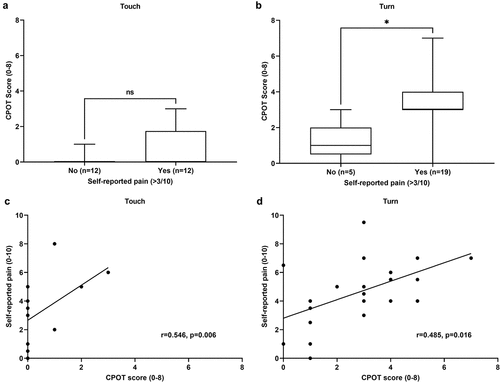Figures & data
Table 1. Study sample demographic characteristics.
Figure 1. Discriminative validation of the Critical-Care Pain Observation Tool. The CPOT scores for each assessment are summarized for the (a) bedside rater, (b) video rater 1, and (c) video rater 2. The data are presented as the line within the box representing the median, upper and lower limits of the box representing the 25th and 75th percentiles, and the whiskers representing the range. Friedman rank sum tests revealed a significant difference in CPOT scores across the assessments for all raters. Post hoc Wilcoxon tests revealed only a significant difference in CPOT scores before and during the turning procedure and during and postprocedure but not between pre- and post-procedure. *P < 0.05, **P < 0.01, ***P < 0.001.

Table 2. CPOT score item frequencies and median total score distributions at each assessment for all raters.
Figure 2. Criterion validation of the Critical-Care Pain Observation Tool. CPOT scores of patients who reported moderate-to-severe pain intensity (≥4/10) during the (a) touching (nonnociceptive) and (b) turning (nociceptive) procedures were compared with patients who reported no to mild pain intensity (0–3/10) with the Mann-Whitney U test. The data are presented as the line within the box representing the median, upper and lower limits of the box representing the 25th and 75th percentiles, and the whiskers representing the range. *P < 0.05. Spearman correlation analyses between the CPOT scores and the self-reported pain intensity was conducted during the (c) touching and (d) turning procedures. Data points = individual patients.

Table 3. ICC values for all assessments.
